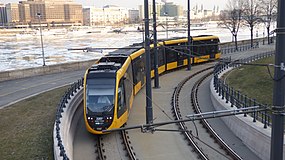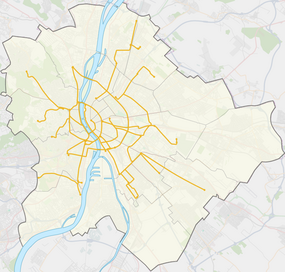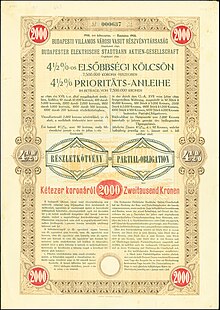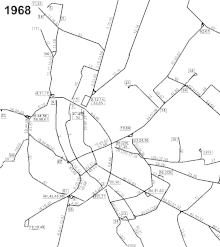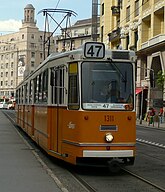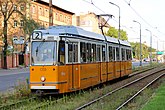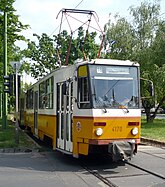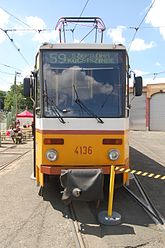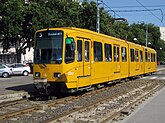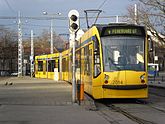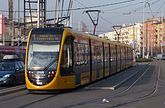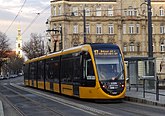Transport in Hungary relies on several main modes, including transport by road, rail, air and water.
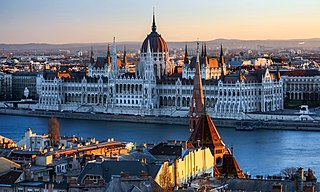
Budapest is the capital and most populous city of Hungary. It is the ninth-largest city in the European Union by population within city limits and it was the largest city on the Danube river; today it is the second largest one. The city has an estimated population of 1,752,286 over a land area of about 525 square kilometres. Budapest, which is both a city and municipality, forms the centre of the Budapest metropolitan area, which has an area of 7,626 square kilometres and a population of 3,303,786. It is a primate city, constituting 33% of the population of Hungary.

Ferencvárosi Torna Club, commonly known as Ferencváros, Fradi, FTC is a Hungarian professional football club based in Ferencváros, Budapest, that competes in the Nemzeti Bajnokság I, the top flight of Hungarian football. Ferencváros was founded in 1899 by Ferenc Springer and a group of local residents of Budapest's ninth district, Ferencváros. Ferencváros is best known internationally for winning the 1964–65 edition of the Inter-Cities Fairs Cup after defeating Juventus 1–0 in Turin in the final. Ferencváros also reached the final in the same competition in 1968, when they lost to Leeds United, as well as the final in the 1974–75 season of the European Cup Winners' Cup, losing to Dynamo Kyiv.

Budapesti Közlekedési Zrt. or BKV Zrt. is the main public transport operator in Budapest, Hungary. BKV was established in 1968 as a unified public transport company with the merger of the companies responsible for the different means of transport; bus operator FAÜ, tram and trolleybus operator FVV, suburban railway operator BHÉV and riverboat operator FHV. The metro was added in 1973. The transport in Budapest underwent another reorganization in 2010 when the BKK was founded for the management of the city transport and infrastructure.

The Budapest Metro is the rapid transit system in the Hungarian capital Budapest. Opened in 1896, it is the world's second oldest electrified underground railway after the City and South London Railway of 1890, now a part of London Underground, and the third oldest underground railway with multiple stations, after the originally steam-powered Metropolitan Railway, now a part of London Underground (1863), and the Mersey Railway, now part of Merseyrail in Liverpool (1886).

BHÉV is a system of four commuter rail lines and rapid transit lines in and around Budapest, Hungary. The BHÉV operates on standard gauge, and is electrified at 1100 V DC.
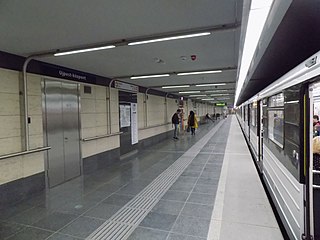
Újpest-központ is the northern terminus of the Budapest Metro Line 3. It is located beneath a busy intersection, the most important public transport hub in Újpest district.

Budapest Déli station, known to locals and foreigners alike simply as the Déli is one of the three main railway stations in Budapest, Hungary.

The Budapest Cog-wheel Railway is a rack railway in the Buda part of the Hungarian capital city of Budapest. It connects a lower terminus at Városmajor, two tram stops away from the Széll Kálmán tér transport interchange, with an upper terminus at Széchenyihegy. The line is integrated into the city's public transport system as tram line number 60, is 3.7 kilometres (2.3 mi) in length, and was opened in 1874.

Deák Ferenc tér is a transfer station on the M1, M2, and M3 lines of the Budapest Metro. It is located under Deák Ferenc square in central Budapest, the capital city of Hungary. Owing to its direct transfer connection between three out of the four metro lines Budapest has and its downtown location, it is one of the busiest stations in the system.
Volánbusz is a network of transit companies operating intercity, international and city bus lines in Hungary. One Volánbusz company generally served only the area of a specific county. The companies formed from the merger of regional Auto Transit Companies and Cargo Shipping Companies.
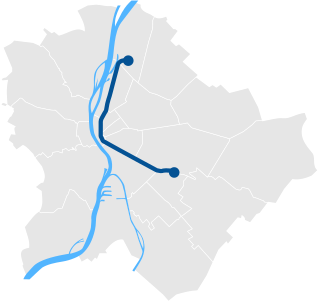
Line 3 is the third and longest line of the Budapest Metro. It runs in a general north-south direction parallel to the Danube on the Pest side, roughly following Váci út south from Újpest to the city center, then following the route of Üllői út southeast to Kőbánya-Kispest. Its daily ridership is estimated at 500,000. Like metro line M1, it does not serve Buda.

BuBi is a bicycle sharing network in Budapest, Hungary. Its name is a playful contraction Budapest and Bicikli, meaning "bubble" in an endearing manner. As of May 2019 the network consists of 143 docking stations and 1,846 bicycles.
The following is a timeline of the history of the city of Budapest, Hungary.
The Budapesti Közlekedési Központ (BKK), officially Budapesti Közlekedési Központ Zrt., is the largest public transport company in Budapest and one of the largest in Europe. It was founded on January 1, 2011. BKK operates buses, trams, and trolleybuses.

Route 200E is a bus route in Budapest. Alongside the 100E express service, it is one of two bus lines serving Ferenc Liszt International Airport. During the day, the line runs between the airport and the nearest Budapest Metro station, Kőbánya-Kispest; at night, it runs to Határ út. 200E operates at all times and is operated by Budapesti Közlekedési Zrt. (BKV) for Budapesti Közlekedési Központ (BKK).
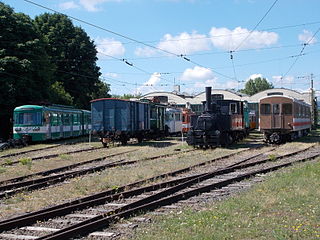
The Urban Public Transport Museum of the Budapesti Közlekedési Zrt. is located in Szentendre, Hungary. The museum opened on July 14, 1992, with five exhibition halls and two showrooms, as well as an open exhibition space in front of the halls. It is open every year from April to October, the entrance fee is one line ticket for adults and one metro ticket for children and pensioners. It is next to the H5 HÉV terminus and the local Volánbusz bus station.
The Tram Line 1 of Budapest is a line operated by BKK Zrt., the transport authority of Budapest. It was commissioned in 1984 between Bécsi út / Vörösvári út and Lehel utca. It then has numerous extension phases, which in 2000 make it possible to connect north to south of Pest along the great ring road, between the Árpád híd and Rákóczi híd bridges. Since March 2015, the line also crosses the Danube in its southern part, and it was further extended in 2019 to Kelenföld vasútállomás M. It now runs between Bécsi út / Vörösvári út and Kelenföld vasútállomás.

Dávid Vitézy is a Hungarian economist, transport and urban mobility expert, politician, who served as Secretary of State for Transport in the Fifth Orbán Government for a brief time from May to November 2022. He is a candidate for Mayor of Budapest in the 2024 Budapest mayoral election.

